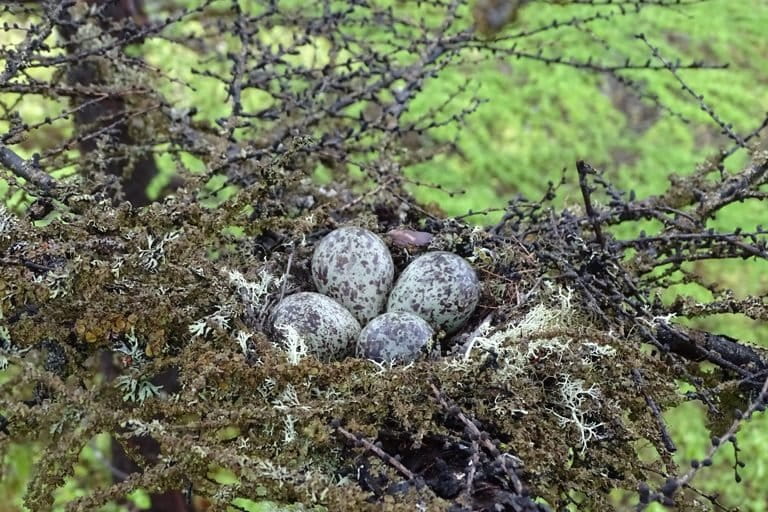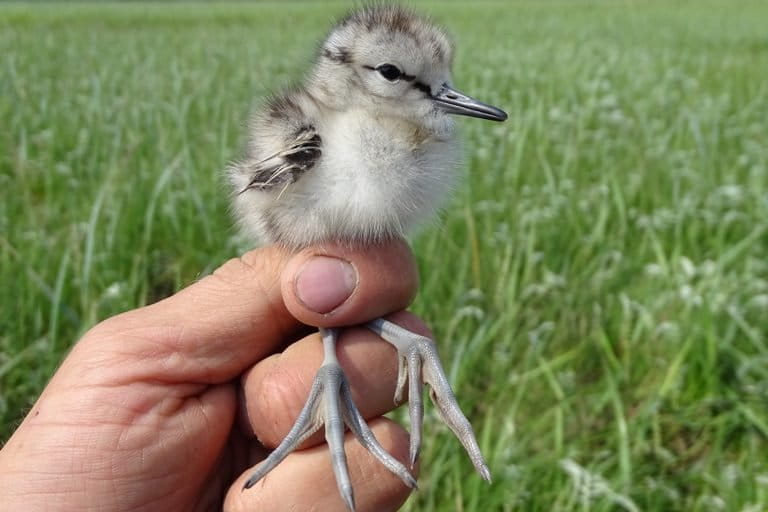- In a remote part of the Russian Far East, researchers have for the first time filmed a nesting Nordmann’s greenshank, a bird that researchers know very little about.
- While the Nordmann’s greenshank forages along the coast where it can be seen more easily from boats, it goes deep into larch forests in very remote locations to nest.
- While the observed nest failed, the team managed to tag seven adult greenshanks and eight chicks with unique leg bands, which will help them track each individual bird as they fly across Asia and back.
- There are believed to be fewer than 2,000 Nordmann’s greenshanks living in the wild today, with the species facing different threats in the various countries and territories through which it passes on its winter migration.
In June this year, researchers surveying a remote part of the Russian Far East finally managed to find what they had been looking for: a Nordmann’s greenshank sitting on a nest, up on a branch of a larch tree.
The discovery was particularly special. The Nordmann’s greenshank (Tringa guttifer) is an extremely rare species of migratory shorebird that breeds in small, isolated parts of eastern Russia, then spends the rest of the year migrating south through various Asian countries, before flying back. It’s a difficult bird to spot in general, but its nests have proven especially elusive for those studying the birds for more than 40 years.
Now, researchers have captured the first-ever footage of a nesting Nordmann’s greenshank.
Finding the nest “was definitely the highlight of the entire expedition,” Philipp Maleko, a graduate student at the University of Florida who was assisting with the survey, told Mongabay.
But it wasn’t easy. The team, led by Vladimir Pronkevich of the Institute of Aquatic and Ecological Problems at the Russian Academy of Sciences, had spent several weeks following and observing Nordmann’s greenshanks on mudflats in the Bay of Sсhastye, in the southwestern corner of the Sea of Okhotsk in the Russian Far East. At some point during their survey, they noticed that a pair of greenshanks would keep flying off into a bog that had patches of larch forests (Larix spp). They kept watch at different sections of the bog, and finally zeroed in on the forest stand the birds would repeatedly visit.
Once inside, they noticed a Nordmann’s greenshank perched on a branch of a larch tree. When they approached the medium-sized sandpiper cautiously to see how it would react, it didn’t fly off very far, Maleko said, suggesting that the area could be part of its territory and that there was a nest somewhere nearby. “We carefully searched every tree limb, every nook and cranny, every crevice until we spotted a Nordmann’s greenshank sitting on a nest,” he said. “We were all jubilant, yet remained calm as to not flush the bird off the nest.”
The Nordmann’s greenshank, also called the spotted greenshank, is among the most threatened migratory shorebirds in the world. With fewer than 2,000 individuals estimated to live in the wild today, the species is listed as endangered on the IUCN Red List. Much of the bird’s life, both in Russia and in parts of Asia, however, remains a mystery.
“Almost nothing is known about their breeding ecology, which makes this new discovery so important,” Pronkevich, who has been studying the Nordmann’s greenshank in Russia for decades, said in a statement.

Video of a nesting Nordmann’s greenshank by Philipp Maleko.
Nests of the bird could have previously gone undetected because of various reasons, Jonathan Slaght, the Russia and Northeast Asia coordinator for the Wildlife Conservation Society (WCS), which partly supported the study, told Mongabay in an email.
While the birds forage along the coast where they can be seen more easily from boats, they go deep into larch forests in very remote locations to nest. In those areas, there are bears and an inhospitable landscape to deal with, which makes getting to the nests a logistical challenge. Numbers of the Nordmann’s greenshank are also declining, which “means that, even if researchers can reach the proper habitat to look for a nest, there may no longer be any birds there,” Slaght said.
“Plenty of Russian scientists have documented evidence of breeding — displaying adults and downy chicks — so the overall distribution of breeding Nordmann’s greenshanks is relatively well known, but the nests themselves have proven elusive for the reasons listed above,” Slaght added.
The last person to have observed a Nordmann’s greenshank nesting, some four decades back, was Russian ornithologist Vitalii Nechaev, Slaght said, who saw the bird actually building a nest by breaking twigs from trees and placing them on a branch.
In fact, building nests in trees makes the Nordmann’s greenshank stand out among other sandpipers, which usually nest on the ground on beaches. Only two other sandpiper species, the green sandpiper (Tringa ochropus) and the solitary sandpiper (Tringa solitaria), are known to nest in trees. But even these two species tend to use old nests of songbirds and other species, Slaght said, and not build one from scratch like the Nordmann’s greenshank has been observed to do.
The nest that Pronkevich, Maleko and Konstantin Maslovskii, a junior researcher at the Russian Academy of Sciences, observed in June, however, failed, with at least two eggs having been eaten by crows.

Despite this, the team isn’t disappointed. The first-ever video of the nesting greenshank aside, they captured the first color photos of an incubating adult, and the first vocalizations of chicks. The researchers also captured seven adult greenshanks and eight chicks, attached tiny, unique bands on their legs, and released them. The bands will help track each individual bird as they fly across Asia and back.
By early August, birdwatchers in Shanghai, China, had already seen three of the banded adults, some 3,000 kilometers (1,800 miles) to the south. The researchers say that most Nordmann’s greenshanks will continue to travel another 3,000 kilometers to Thailand and Malaysia for the winter, with some returning to the Bay of Sсhastye next spring.
Maleko and his colleagues say they hope their study will help them identify key breeding, migratory and wintering sites of the greenshank.
“This identification will allow us to assist in the conservation and protection of sites necessary for the Nordmann’s greenshank’s survival,” Maleko said. “The 2019 season gave us an extraordinary amount of new information about their nesting ecology; and on different methods of capture, methods that are certain to work in the future if additional tagging is undertaken.”
Conservation of a rare, migratory species like the Nordmann’s greenshank is a huge challenge, though. A study published in 2018 found that most of the Nordmann’s greenshank population winters in Thailand and Malaysia, with smaller numbers in Myanmar and Sumatra. Most of the sites in which they occur are unprotected. The species also passes through numerous other countries, including mainland China, Hong Kong, South Korea, Japan, North Korea, India, and Sri Lanka, and is known to winter in Bangladesh, Cambodia, and Vietnam.
The birds spend different amounts of time in these countries, where they are governed by different laws, Slaght said. Moreover, while some of the biggest threats to the greenshank in Southeast Asia are illegal hunting and the loss of coastal wetland habitat, the type and extent of threats differ across countries and sites.
The key to protecting the Nordmann’s greenshank, Slaght said, would be to understand where the birds occur and which threats they face in those places. As for the breeding grounds in Russia, researchers need to learn more about their breeding ecology to start identifying threats, he added.
A lot of questions remain unanswered. But for now, the video of the greenshank nest has conservationists excited.
“For Asian waterbird conservationists and many birdwatchers, the nest of a Nordmann’s greenshank is akin to a Holy Grail or a white whale: something mysterious that you know exists, is somewhere out there, but remains hidden,” Slaght said. “In today’s world, where access to information is instant, it is refreshing to know that something like a sandpiper has been able to guard its secret from us for so long. But now that Pronkevich, Maleko, and Maslovskii know what to look for, I think they will find more nests and we can finally begin to piece together the nesting ecology of this enigmatic species.”

Banner image of a nesting Nordmann’s greenshank by Philipp Maleko.
Correction (2019-09-04): An earlier version of the article said that Maleko and his colleagues had captured the first photos of an incubating Nordmann’s greenshank. This has been changed to first color photos. The first photographs of an incubating adult were taken by Nechaev in 1976.
